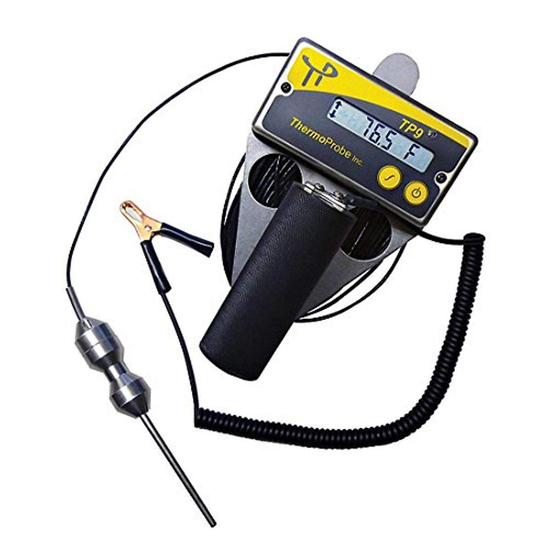
Table of Contents
Advertisement
Quick Links
USER INSTRUCTIONS - TP7C & TP9
INTRODUCTION
This manual describes the basic function, use and safety instructions for a model TP7C or TP9 portable digital thermometer
instrument. These ThermoProbe instruments are intended for use in both hazardous (flammable) and non-hazardous areas under dry
conditions at ambient temperatures between -20 to 40°C. The instruments are not intended for use in permanent outdoor installations
and are not intended or tested for icing conditions. Additional means of protection should be used where the equipment may be
exposed to excessive external stresses (e.g. vibration, heat, impact, etc.).
SAFETY INFORMATION BEFORE USE
ThermoProbe thermometers are designed for safe operation in hazardous locations (Potentially Flammable or Explosive). The user
must have a working knowledge of appropriate safety instructions.
a) The inspector must have a thorough knowledge of the products to be measured and must know of the safety precautions to be
taken when working with the material to be measured.
b) The instrument shall be checked concerning severe defects; check that instrument is complete (including grounding/bonding
cable), has good batteries, etc. If necessary, check measurement accuracy. If any defects are found, the instrument should not be used
until repairs have been made.
c) The instrument, especially cable and probe, should be clean both for safety reasons and ease of use.
d) The physical measurement location should be evaluated for primary and secondary risks.
e) Power source must be removed before performing any maintenance.
f) Exchange of components other than the batteries may compromise ATEX/IECEx certification and shall only be undertaken by
Thermoprobe or one of its qualified service providers. See also "Authorized Repair" section.
g) To reduce the risk of fire or explosion, this device must be bonded to the tank according to clause 6.3.2 e), IEC/EN 60079-14
before and during introduction into the tank and shall remain bonded until complete withdrawal from the tank.
h) The device must remain bonded to ground/earth using the provided connection whenever a hazardous atmosphere could be present
as well as during situations where electrostatic charging can occur such as the unwinding/winding of the thermometer cable or filling
or emptying of the tank.
CAUTION: In the event that any part of the instrument should become electrostatically charged in a potentially hazardous location,
follow company policies for testing and clearing the area of any hazardous gases before attempting to bond the instrument to earth
ground. If this is not possible allow sufficient time for the instrument to naturally dissipate any charges before attempting to bond to
earth ground. Given the atmosphere, this could take several hours.
GUIDANCE NOTE
Problems with aggressive substances and environments: Be aware of aggressive substances and that extra protection may be needed.
Caustic soda, highly basic and acidic substances will erode aluminum and copper ground clip and wire. The Sensor-Cable assembly
has external surfaces of stainless steel and fluoropolymer material. Exposure to Excessive heat can melt the plastic components of
the instrument.
11/2012, JK
Advertisement
Table of Contents

Subscribe to Our Youtube Channel
Summary of Contents for ThermoProbe TP7C
- Page 1 USER INSTRUCTIONS - TP7C & TP9 INTRODUCTION This manual describes the basic function, use and safety instructions for a model TP7C or TP9 portable digital thermometer instrument. These ThermoProbe instruments are intended for use in both hazardous (flammable) and non-hazardous areas under dry conditions at ambient temperatures between -20 to 40°C.
- Page 2 Safety Approvals for TP7C and TP9: II 2 (1) G Ex ib [ia] IIB T4 Applicable Standards are: Agency or Safety Designation IEC 60079-0:2007 Ed. 5 IECEx IEC 60079-11:2006 Ed. 5 IECEx EN 60079-0: 2009 Europe: ATEX EN 60079-11:2007 Europe: ATEX INTRINSIC SAFETY Intrinsically safe equipment is defined as "equipment and wiring which is incapable of releasing sufficient electrical or thermal...
- Page 3 Ensure the instrument is in a non-hazardous area. b) Remove the 3 screws holding the front cover on the TP7C or the 2 screws holding the front cover on the TP9. c) Remove battery retaining device, push one battery towards the spring contact and lift battery up from the holder, and then remove the remaining battery.
- Page 4 USER INTERFACE Power Button Function Button “Power” Button Pressing the Power button once will turn on the device. The instrument will shut off automatically within 20 minutes. Pressing the Power button twice (within 1 second) will save whatever reading is on the display. Pressing and holding the Power button will and shut the instrument off and clear all logged and averaged readings.
- Page 5 2) Please refer to IEC/EN 60079-19 when making the repair 3) Only use replacement probe assemblies obtained from ThermoProbe, Inc. or one of its authorized distributors with part specifications as follows: a) First follow REPLACING BATTERY instructions a through c to remove batteries.
- Page 6 Figure 1: Probe Assembly Lead Attachment CALIBRATION PROCEDURE • The calibration mode should only be accessed by qualified personnel with proper equipment; otherwise calibration integrity may be compromised. Read the following instructions carefully. • A 2-Point, 3-Point or a 4-point calibration can be performed. A third or fourth point is only necessary when high accuracy is required at temperatures of 300°F and higher.
- Page 7 To calibrate proceed with the following steps: 1. A hidden Calibration Button is located on the front overlay underneath the ThermoProbe logo (see diagram above). While the instrument is on, first press and hold the “f” Button, and then press and hold the hidden Calibration Button until the...




Need help?
Do you have a question about the TP7C and is the answer not in the manual?
Questions and answers